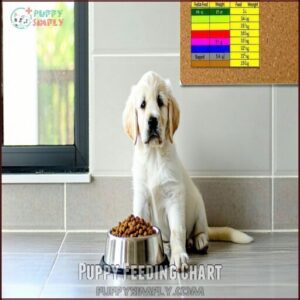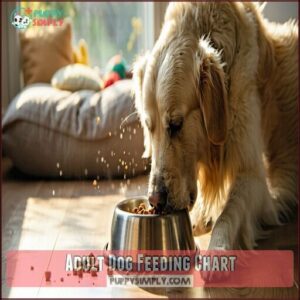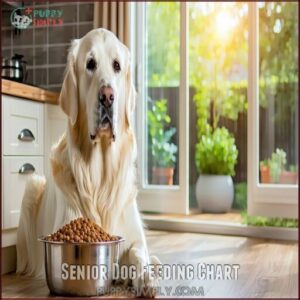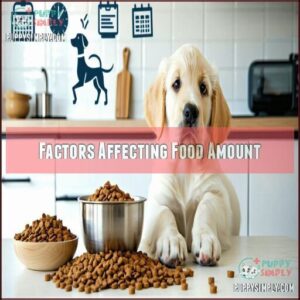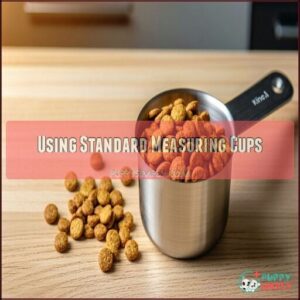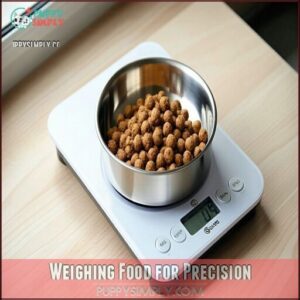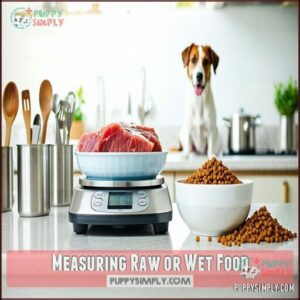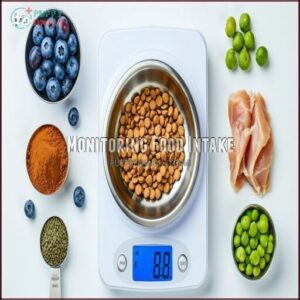This site is supported by our readers. We may earn a commission, at no cost to you, if you purchase through links.
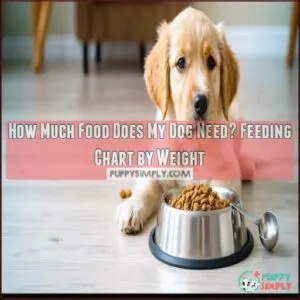 Figuring out how much food your dog needs isn’t a one-size-fits-all deal. It depends on their weight, age, activity level, and health.
Figuring out how much food your dog needs isn’t a one-size-fits-all deal. It depends on their weight, age, activity level, and health.
For example, an active, medium-sized adult dog weighing 30 pounds might need about 1.5 to 2.5 cups of dry food daily, while a quiet senior of the same size could need less. Puppies eat smaller meals more often, and their needs can change fast as they grow.
Overfeeding can lead to weight gain, while skimping can leave them hungry or undernourished. Always check your dog’s food label and consult your vet to get it just right.
Small changes matter! Always prioritize your dog’s health by being mindful of their dietary needs and adjusting as necessary to ensure they receive the proper amount of food.
Table Of Contents
- Key Takeaways
- Dog Feeding Guidelines
- How Much Food Needed
- Feeding Chart by Weight
- Factors Affecting Food Amount
- Measuring Food Accurately
- Customizing Feeding Plans
- Monitoring Food Intake
- Frequently Asked Questions (FAQs)
- How much should I Feed my Dog?
- How much food should you feed a puppy?
- How much food should a puppy eat a day?
- How much food should a 20 pound dog eat?
- How much should my dog eat a day chart?
- How do I calculate how much food my dog needs?
- What is the 80/20 rule for dog food?
- Is 2 cups of dog food a day enough?
- Do dogs need 1 or 2 meals a day?
- How many cups of food should one eat daily?
- Conclusion
Key Takeaways
- Adjust your dog’s food portions based on their weight, age, activity level, and health to keep them happy and healthy.
- Use feeding charts, measure accurately, and control treats to avoid overfeeding or underfeeding your dog.
- Monitor your dog’s weight and body condition regularly to fine-tune their diet as their needs change.
- Consult your vet for personalized feeding advice and adjust as needed for life stages, activity, or health conditions.
Dog Feeding Guidelines
Feeding your dog the right amount is key to their health and happiness, preventing issues like obesity or malnutrition.
By considering factors like weight, age, and activity level, you can tailor their meals to meet their unique needs, which is crucial for preventing issues like obesity.
Importance of Proper Feeding
Feeding your dog properly isn’t just about keeping them full—it’s key to their lifelong health and overall wellbeing.
Proper dog feeding nurtures lifelong health, supports ideal weight, and keeps them happy and active every day.
Sticking to dog feeding guidelines helps prevent obesity, supports them in maintaining an ideal weight, and supports a happy, active life.
- Too much food leads to weight gain and joint issues.
- Too little food causes weakness and health problems.
- Customized plans fit your dog’s unique needs.
- Dog calorie needs vary by size and activity, which is crucial for a happy, active life.
Factors Influencing Feeding Amounts
When figuring out how much to feed your dog, many factors come into play.
Breed genetics, spay/neuter status, and food type can all affect their needs. Active dogs burn more calories, while individual metabolism varies.
Use a dog feeding guide or dog food calculator to fine-tune portions.
Treat allowance matters too—those small extras add up fast! Tailor dog food portions carefully for balance.
Health Risks of Overfeeding and Underfeeding
Both overfeeding and underfeeding your dog can lead to serious health issues.
Overfeeding or underfeeding your dog isn’t just risky—it can lead to long-term health problems and affect their happiness.
Obesity complications like organ damage and joint problems reduce quality of life, while malnutrition effects, such as immune deficiency and nutritional deficiencies, harm overall well-being.
- Excess weight strains joints, causing pain.
- Overfeeding may damage essential organs over time.
- Underfeeding weakens the immune system.
- Nutritional deficiencies slow growth or healing.
- Health issues shorten your dog’s lifespan.
How Much Food Needed
Knowing how much food your dog needs starts with understanding their calorie requirements. Different factors impact dog feeding amounts, so use a feeding guide to estimate a proper dog food serving size. Stick to weight-specific recommendations for better portion control and check food labels for calorie content.
Don’t forget hydration, as water is essential. Diets for large breeds require careful calcium consideration to support healthy development.
- Monitor weight changes to adjust feeding.
- Account for treats; they shouldn’t exceed 10% of calories.
- Match portions to activity level and age.
- Use a daily dog food routine.
- Prioritize hydration needs.
Feeding Chart by Weight
Feeding your dog the right amount of food depends on their weight, which serves as a key guideline for portion sizes.
This chart provides clear recommendations to help you keep your dog healthy and properly nourished.
Puppy Feeding Chart
Puppies thrive with the right balance of nutrition, formulated to their growth stages and breed differences.
A puppy feeding chart guarantees proper portioning. It’s also vital to understand the newborn puppy feeding schedule for ideal health.
Use the table below for guidance:
| Weight (lbs) | Age (weeks) | Meals/Day | Daily Food (cups) | Portioning Tips |
|---|---|---|---|---|
| 3–12 | 6–12 | 4–6 | 1/2–1 | Small portions |
| 13–20 | 6–12 | 4–6 | 1–1¼ | Avoid overfeeding |
| 21–50 | 6–12 | 4–6 | 1½–2 | Gradual increases |
| 51–75 | 6–12 | 4–6 | 2–3 | Monitor weight |
| 76–100 | 6–12 | 4–6 | 2½–3¾ | Adjust as needed |
The key to successful puppy feeding is finding the right balance and following a well-structured plan, ensuring healthy growth and development.
Adult Dog Feeding Chart
Adult dogs need well-balanced portions to maintain energy and health.
Use this dog feeding chart based on weight to guide you:
| Weight (lbs) | Daily Cups | Calories Needed |
|---|---|---|
| 3-5 | ½-¾ | 208-234 |
| 20-30 | 1⅓-2⅓ | 586-659 |
| 30-50 | 2-2⅔ | 795-895 |
Always adjust for factors like activity, breed variations, and food types.
Senior Dog Feeding Chart
As dogs age, their dietary needs change to support joint health, cognitive function, and digestion.
Senior dog diets focus on calorie reduction while enhancing nutrients for dental and overall health.
Use the chart below for guidance:
| Weight (lbs) | Cups/Day |
|---|---|
| 18–23 | 1–1⅓ |
| 24–45 | 1⅓–2¼ |
| 46–65 | 2⅓–3 |
| 66–85 | 3–3⅔ |
| 86–105 | 3¾–4⅓ |
Adjust portions for individual needs to ensure optimal health and consider the importance of calorie reduction.
Factors Affecting Food Amount
How much food your dog needs depends on several factors, like age, size, activity level, and overall health.
These elements help determine the right portions to keep your dog healthy and energetic.
Age and Life Stage
A dog’s age and life stage shape their feeding needs.
Puppy nutrition demands extra calories, protein, and minerals for growth.
An adult dog diet focuses on maintenance, keeping energy steady.
Senior diets, on the other hand, often minimize calories to help manage slower metabolisms, while pregnancy needs and lactation support require higher energy intake.
Tailor meals thoughtfully based on these stages.
Activity Level and Size
You’ll need to factor in your dog’s activity level and size when using a dog feeding chart.
Active breeds burn more calories and need more food, while smaller or less active dogs require careful portion control to avoid excess weight.
A calorie calculator helps tailor calorie needs based on exercise impact, breed differences, and weight, ensuring your dog stays healthy and energized.
Health Conditions and Breed
Some breeds require special feeding considerations due to genetic factors and health status.
Dietary management can address breed predispositions like joint issues in large or giant breeds or heart conditions in retrievers.
Specific ailments may demand veterinary diets formulated for small breeds.
- Large breeds benefit from controlled calcium.
- Copper-sensitive breeds need low-copper foods.
- Grain-inclusive diets may reduce DCM risks.
- Consult your vet for breed-specific feeding.
Measuring Food Accurately
Measuring your dog’s food accurately is essential to maintain their health and prevent overfeeding or underfeeding.
Using tools like measuring cups or a food scale guarantees you’re giving the right amount every time, which is a complete concept in dog care.
Using Standard Measuring Cups
A standard measuring cup is essential for portion control, ensuring accurate dog food measurement. Always use a dedicated, dry material cup for kibble—don’t guess or overfill.
Wet food measuring techniques differ; consult feeding guides for exact portions. Cup materials matter—plastic warps over time, reducing accuracy.
Store cups properly to maintain Cup Accuracy, as improper storage impacts measurement reliability. You can even find specialized cups for dogs to help with this task.
Follow dog feeding charts to know how much to feed your dog, ensuring you provide the right amount for their needs, which is crucial for their health.
Weighing Food for Precision
A digital scale is the gold standard for dog feeding measurement.
It guarantees consistent measurement by letting you weigh food in grams, which is far more accurate than relying on cups.
Since food density varies, grams vs cups can make a big difference in portion control.
For accurate measurements, you might consider a dog food scale.
Precision matters for calorie counts, helping you keep your dog’s diet on track and their health in check, which is a key aspect of dog feeding.
Measuring Raw or Wet Food
Measuring raw or wet food isn’t tricky, but it takes precision.
Use these steps for accuracy:
- Use Measuring Tools like kitchen scales for Raw Food Volume or Wet Food Density.
- Portioning Methods guarantee correct amounts per dog feeding measurement.
- Follow feeding guidelines and your dog’s specific feeding chart.
- Stick to Hygiene Practices—clean tools after use.
Adjust amounts for a raw dog food diet based on activity levels. A raw food scale guarantees accurate measurements.
Customizing Feeding Plans
Creating a feeding plan customized to your dog’s needs guarantees they get the right nutrition to stay healthy.
By considering factors like health, age, and activity level, you can adjust meal portions for ideal well-being.
Individual Health Conditions
Tailoring your dog’s diet to their health status is key. For specific ailments like obesity or diabetes in dogs, dietary adjustments guarantee proper nutrient balance.
Medications and conditions may impact weight management, so work with a veterinarian to address unique needs. Specialized foods can support dog health by easing strain on organs or aiding recovery.
Always consider veterinary guidance for safe, effective feeding strategies, and remember that proper nutrient balance is crucial for your dog’s well-being.
Working With Veterinarians
A veterinarian consultation helps you fine-tune your dog’s feeding routine.
Veterinary advice guarantees dietary adjustments match medical conditions and breed predispositions.
With personalized nutrition plans, you can address weight management effectively.
Veterinarians assess health, activity levels, and body condition, offering customized guidance.
Consider breed specific formulas for ideal puppy growth.
Trust their expertise when body condition or health factors suggest changes—it’s like having a partner to keep your dog thriving.
Adjusting Portion Sizes
After consulting your vet, adjust portion sizes based on changes in activity, weight, or health.
Use body condition score assessment to guide calorie adjustments. Treat allowance matters too—keep it small to avoid overfeeding.
Weight monitoring helps fine-tune dog feeding portion control. Dietary adjustments guarantee balanced nutrition, supporting your dog’s health.
Remember, portion sizes aren’t fixed; adapt them as your dog’s needs evolve with veterinary guidance.
Monitoring Food Intake
You need to regularly monitor your dog’s food intake to maintain their ideal weight and health.
Checking their weight and body condition helps you adjust portions and make sure they’re getting the right amount of nutrients.
Regular Weight Checks
Regular weight checks help you monitor your dog’s health and keep their ideal weight on track.
Weigh your dog monthly using a home scale for accuracy, or during vet visits.
Photo monitoring can also highlight changes over time.
Weight fluctuations can signal overfeeding, underfeeding, or health issues, so pair this with body condition score assessments and dog feeding charts for effective dog weight management.
For puppies, it’s also important to select puppy food options designed for weight management.
Body Condition Scoring
Body condition scoring helps you monitor your dog’s ideal weight and overall health.
Use visual assessment and palpation techniques to evaluate them on a scale of 1–9, where 4 or 5 is the ideal score.
This method supports dog weight management by adjusting feeding as needed.
Remember, breed variations can impact your dog’s body condition, so always account for their unique needs when ensuring proper weight management.
Adjusting Food Amounts and Transitioning Food
Evaluating your dog’s feeding needs starts with observing weight and body condition score.
Gradual changes during a dog food switch prevent upset stomachs.
Follow these steps:
- Adjust portions as your dog’s activity level or weight shifts.
- For picky eaters or food allergies, try recipe customization or dietary supplements.
- Monitor calorie intake to confirm proper dog feeding adjustments.
Small tweaks keep your pup’s diet balanced!
Your dog will benefit from these gradual changes and proper adjustments.
Frequently Asked Questions (FAQs)
How much should I Feed my Dog?
Imagine a sprinter versus a couch potato—your dog’s size, age, and activity level dictate food needs.
Use weight-based feeding charts, but adjust portions for ideal body condition.
Treats should stay under 10% of calories.
How much food should you feed a puppy?
Puppies need 2–5 meals daily, depending on their age.
For guidance, check the puppy food’s label or consult your vet.
Growth rates vary, so adjust portions as needed to maintain a healthy weight.
How much food should a puppy eat a day?
Portion puppies properly! Feed based on their size, age, and breed.
For example, a 5-pound pup might need ½–1 cup daily, divided into meals.
Always check feeding charts and visit your vet for specific advice.
How much food should a 20 pound dog eat?
A 20-pound dog typically needs about 1¼ to 1⅔ cups of food daily, divided into two meals.
Adjust portions based on activity level, age, and food type.
Consult your vet for personalized recommendations.
How much should my dog eat a day chart?
A dog’s daily food needs vary by weight, age, and activity.
For example, a 20-pound dog typically eats 1¼–1⅔ cups daily.
Always check the food package’s chart or consult your vet for precision.
How do I calculate how much food my dog needs?
To calculate your dog’s food needs, use the formula: 30 x weight in kilograms + 70 for resting energy requirement (RER).
Adjust for age, activity level, and health.
Consult feeding charts or your vet for precision.
What is the 80/20 rule for dog food?
The 80/20 rule for dog food means 80% of your dog’s diet comes from balanced, nutritious meals, while 20% consists of healthy treats. This balance helps maintain weight and overall health without overindulging.
Is 2 cups of dog food a day enough?
Two cups might be enough, depending on your dog’s size, age, and activity level.
Check the feeding chart on your dog food bag, or consult your vet to confirm you’re meeting their daily nutritional needs.
Do dogs need 1 or 2 meals a day?
Most adult dogs thrive on two meals daily, keeping them energized and preventing hunger spikes.
Puppies typically need 3-4 meals, while some seniors do well with one.
Stick to what suits your dog’s routine.
How many cups of food should one eat daily?
Over 55% of dogs in the U.S. are overweight, highlighting the need for proper portions.
Feeding varies by size, age, and activity, but follow the food bag’s guidelines and adjust with your vet’s advice.
Conclusion
Feeding your dog the right amount of food isn’t rocket science, but it can feel like it.
Use their weight, age, and activity level as starting points, and remember, the feeding chart is your best friend.
Watch for changes in body condition and weight, adjusting portions as needed to keep them healthy.
Always measure food accurately and consult your vet for advice.
Taking small steps guarantees your dog gets exactly what they need to thrive!
- https://vetcalculators.com/calories.html
- https://petobesityprevention.org/2021
- https://petnutritionalliance.org/resources/calorie-calculator?type=dogs
- https://wsava.org/wp-content/uploads/2020/07/Calorie-Needs-for-Healthy-Adult-Dogs-updated-July-2020.pdf
- https://www.aafco.org/wp-content/uploads/2023/01/Pet_Food_Report_2015_Annual-1.pdf



